Paper Doll To the Rescue: How To Save Wet Books & Documents
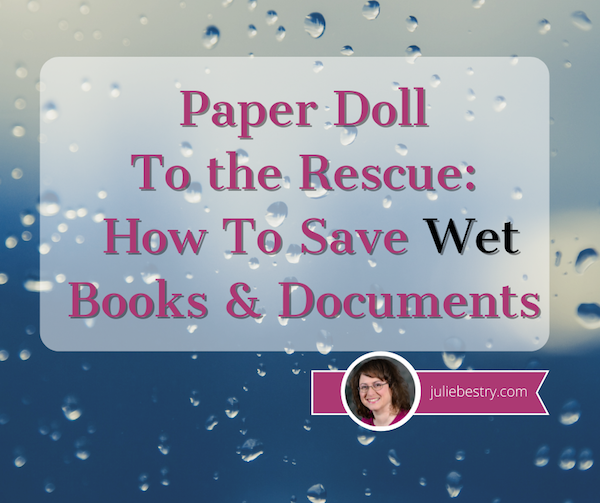
For something that’s supposed to be so good for us, water can cause quite a bit of trouble.
If you drop your cell phone in water, people will rush to tell you to stick it in rice, as though your Samsung or iPhone was a nice piece of baked salmon. It seems everyone has heard and shared that little hack for rescuing wet electronics.
For what it’s worth, you actually shouldn’t put your soaked phone in rice. Phone experts say airflow, not rice, is the key. Apple agrees. Desiccants and air-tight pouches can also help.
So, save the San Francisco Treat for your dinner table, OK?
There’s a common expression when people are talking about all their drawers and piles of papers and books. They say, “I’m drowning in paper.” But what happens when your paper drowns?
Have you ever dropped your book in the tub? Failed to zip your backpack up all the way and had a book land in a puddle? Had someone overzealously splash you while you’re reading poolside?
Ever have your garbage disposal eat a fork, spring leaks, and send all the water running down your drain through a cracked pipe and into your cabinets, soaking books on the other side of the wall? (Yes, that is TOO a thing that happens. Stop looking at me like that.)
What happens when a book gets wet? Well, the first thing that happens is cockling. That’s the official term for when paper (especially bound paper) gets wet and bulges out in certain places, presenting a warped, wrinkled, puckered, or creased surface.
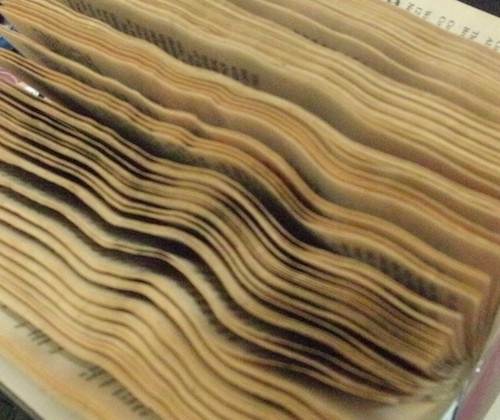
The worst part isn’t the cockling though. (C’mon, people, stop laughing at the word “cockling!”) The biggest concern should be mold. Mold can begin growing within 2-to-3 days, and because mold spores can flourish wherever conditions are warm and wet, you want to jump on solving your wet-paper problem right away!
I should note, Paper Doll is an expert on organizing paper, not restoring it. But I’ve sure had some interesting requests over the years. One client, whose entire library was along a leaking outside wall, wanted to “save” mold-covered books by taking nail scissors and cutting along the edges of the pages to rid them of mold. (No, this wasn’t possible. Not all mold is visible, and mold can be damaging to one’s neurological and respiratory systems. Don’t play around with mold!)
And clients have often asked how to restore important (though not necessarily financially valuable) books, like family Bibles, which have seen better days. For a book with serious financial or sentimental value, please seek the expertise of a professional book restoration service. Check out the website of the The American Institute for Conservation and do a zip code radius search on their Find a Conservator page.
RESTORING WATER-DAMAGED BOOKS
How you deal with a water-damaged book depends on whether the water left your book damp (as if it had been in a sauna), wet (as if you were caught in the rain between your parking space and your building) or soaked all the way through (like the most miserable camping trip, ever)!
If your book is damp, experts advise that you:
- Hold the book gently by the spine and shake the book side-to-side to rid it of any excess water.
- Gently remove any debris. (This works better if you’re trying to get stray leaves out of the book dropped in a shallow puddle; if you spilled your milkshake on the book, you’re not going to get bits of chocolate off of the pages so easily.)
- Cover the surface of wherever you’re going to dry the books with either absorbent paper (like unprinted newsprint — no, NOT actual newspaper!), absorbent towels, or plastic sheeting. This way, as the book dries, the surface you’re using won’t get damaged. The more books you have to restore, the more space you’ll need, as this is often a multi-day process.
- Stand your book up and fan it out so no part is open more than 60°. Official advice will say to stand the book on its “head” or “tail” which just means that you’re not resting the book on its spine or on the part where it opens. Fanning it out means just that — if viewed from above, it’ll almost look like a fan.
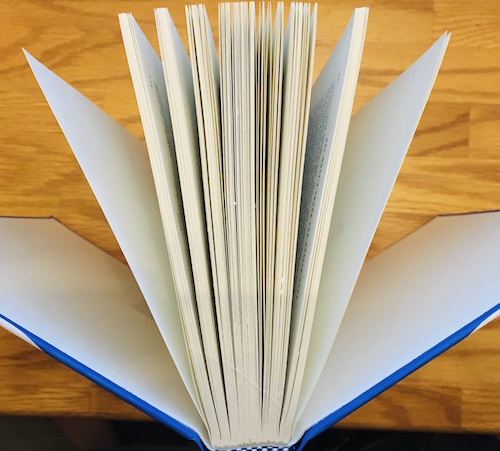
- If it’s mostly the book cover (of a hardcover book) that’s damp, but not the actual text of the book, put some absorbent paper towels between the “boards” of the cover and the pages. Change as necessary (when the paper has absorbed all it can).
- Use fans in the room to circulate air so the book will dry, but don’t point the fans directly at the book.
- If you have a dehumidifier, this is the time to pull it out! Air conditioning is good, too. But none of the air blowing on the book should be so strong as to make the pages flutter.
- Once the book is completely dry, lay it on its back cover, sandwiched between two wooden boards, and place something heavy (like a few bricks or an old-fashioned, massive hardcover dictionary) on top of it, making sure the spine (of the previously damp book) isn’t smushed by the weight. Or, you can use a book press, if you happen to have one of these babies hanging around.
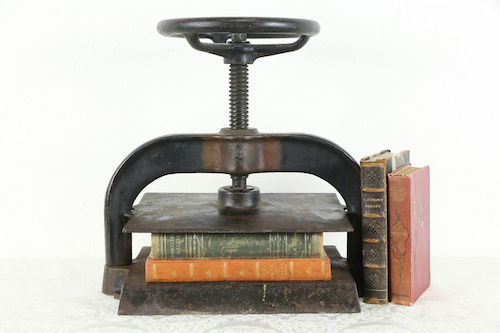
RestorationMaster suggests that for paperbacks (which are usually more slender than hard cover books), you can hang the book on a bit of fishing line or string to help it air dry. (But only do this if the book isn’t soaking wet, or the its own weight could cause the book or its binding to tear.)
If the book is wet, think about the value of your time vs. the value of the book. If it’s a $300 textbook, your willingness to carry on may be different from what it would be if it’s a paperback novel.
- Cover your work surface, as described above.
- Lay the book flat and open it carefully (so as not to rip any of the wet pages) and start interspersing (interleaving, in book restoration talk) paper towels about every 20 pages, working from the front to the middle of the book. Once you get to the middle, flip the book over, and repeat the process from the back to the middle.
- Leave the book flat for about an hour so the paper towels can absorb some of the water. (If your book got that wet, chances are good some of your other stuff got wet. Go check on them.)
- Hour is up? Stand the book up, fanned, on the “head” or “tail” as described in the “damp” section, above.
- Switch out the surface covering and paper towels as they soak up the water, and periodically repeat the process until the book is “only” damp.
- Now follow the directions for damp books, above.
It’s hard to envision some of these steps, so I was delighted to find this video from Syracuse University, where I attended graduate school many, many years ago. Their Department of Preservation and Conservation illustrates how to save damp and wet books from becoming wrinkly, moldy goop.
(For more information, you may also want to peruse the Disaster Recovery Manual for the Syracuse University Libraries.)
If your book is soaked through, meaning it fell into a pool or your house flooded to the point that your book was submerged, this is really a job for professionals. The instructions below describe what they’ll do, not what you should do. Unless you are a restoration specialist, you are likely to be out of your depth. That said, there are two possible measures:
1) Air-Dry (For those of us for whom humidity makes us resemble Art Garfunkel, “air-dry” already has some unfortunate connotations!)
This is basically an advanced version of the solution for “wet” books above, with a few changes:
- DON’T OPEN THE BOOK (to the interior). Don’t fan the pages.
- Put paper towels between the front and rear covers and the interior of the book.
- Use those fans! Turn on the A/C. Get out the dehumidifier. And be patient.
2) Freeze!
WAIT! Stop pulling the Eggos and last night’s leftovers out of the freezer to make room. Freezing books keeps mold and mildew from growing and gives professional restorers some extra time to plot out their attack.
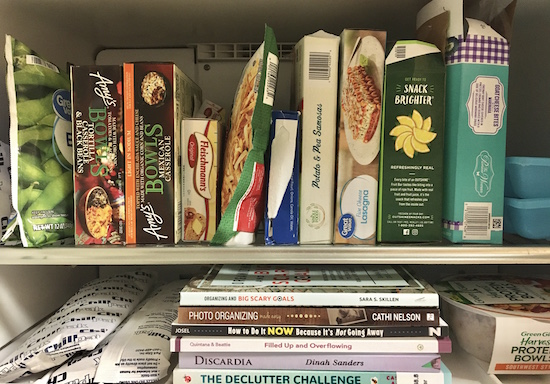 But to save soaked books, restorers use rapid freezing methods at temperatures down to -20°F (-28.9°C) so ice crystals won’t form on the books. Unless you’ve got a seriously fancy-pants freezer, your Frididaire probably isn’t going to cut it.
But to save soaked books, restorers use rapid freezing methods at temperatures down to -20°F (-28.9°C) so ice crystals won’t form on the books. Unless you’ve got a seriously fancy-pants freezer, your Frididaire probably isn’t going to cut it.
Once the wet books get frozen, restorers use vacuum freeze-drying to remove moisture, similar to how food is freeze-dried.
The water in the damaged book goes from being a solid (picture microscopic ice cubes) to a gas (think: water vapor) without ever turning into liquid.
This is called sublimation. (Is this starting to remind you of high school chemistry class? Or maybe you soaked your high school chemistry textbook and never read anything the rest of the semester?)
By skipping the liquid stage, there’s less of a chance of the paper cockling, the cover (boards) warping, or the ink running. This is good. But again, this is really the work of a professional.
That said, a number of resources, including WikiHow, advise that you can repair a wet book by freezing it in a regular household freezer. (Scroll down on the linked page to see their Method #2.) They advise removing excess water by interleaving small sets of pages with white paper towels, as described above, and then putting the damaged book into a zipper-lock plastic bag, and sealing it. (They warn, “Do not perform a vacuum seal, however; you want some air to be able to reach the book’s pages, and some space to be between the texture of the bag and the book itself.” OK, then!)
WikiHow says to keep the book in the freezer 1-2 weeks, depending on how long the book is. (So, go the full fortnight if it’s all 963 pages of Anna Karenina, which, coincidentally, Paper Doll just finished reading. I wish I could have frozen the chapters on wheat threshing, let me tell you!)
Then, when you pull the book out, you’ll go back to the methods for “damp” and “wet” books above, because you, my friends, do not have a vacuum freeze-drying machine for books. You got a lot of the water out, but as the book defrosts, there will still be moisture!
Anna Gooding-Call of Book Riot notes that the ice crystal problem (obviated by the fancy vacuum freeze-drying used by professionals) is a bigger deal. She notes, “To a certain extent, you might not be able to avoid this because you are a normal human being and you have a normal human being’s freezer. Ice can wreck your book for the same reason as it can wreck your fleshy body: freezing water expands and ruptures things. Set your freezer to its lowest setting—as in, the warmest temperature relative to how freezy it can possibly get—and check frequently. If you have a no-frost function, use it!”
The Houston Chronicle has similar advice about freezing, but notes that if there are any coated pages in a doused book, such as in a section of illustrations or photos, take extra precautions. Because coated pages may fuse together if not separated, their article advises putting a sheet of wax paper between every coated page to isolate each one.
Interleaving, fanning, freezing. This is a lot of work!
For what it’s worth, WikiHow also has instructions for rescuing your damp books using a hair dryer. After removing excess water, they recommend laying the book down on an absorbent towel and aiming the dryer at the pages, top-to-bottom, a few at a time, and not moving onward until the pages you’ve worked on are dry.
I once tried this dryer method, but it still yielded a LOT of cockling, and in the end, I had to reimburse the public library for a new copy anyway. Reader, beware.
Beyond that, my undergraduate alma mater, Cornell University, specifically says NOT to use heat to dry books! Cornell’s exact (final) words on the subject are:
CAUTION
Do not use artificial heat to try to speed the drying, as this will lead to dimensional distortion.
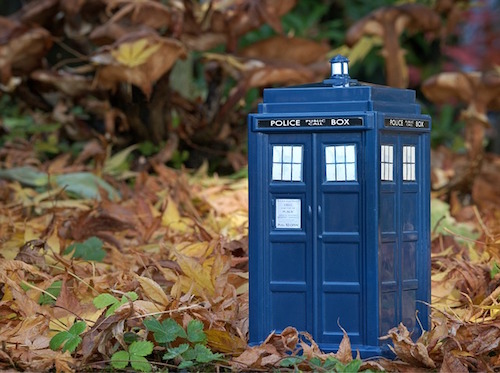 Undergrowth Doctor Who (MaxPixel)
Undergrowth Doctor Who (MaxPixel)
“Dimensional distortion” sounds like something that’s better handled in Doctor Who than the Paper Doll blog, so we’ll just leave that right there.
RESTORING WET DOCUMENTS
Let’s say you haven’t soaked a book, but perhaps you were working on your family filing and a tiny human or furry friend got over-excited and upturned your glass of water. Most of the solutions for books will work just as well for individual papers.
The Library of Congress has a page of advice for emergency preservation of museum collections of paper, and this guidance is easily applied to your important documents at home:
- Create your safe workspace (away from the tiny humans, furry friends and, your beverages).
- Lay your wet papers flat on clean absorbent towels or unprinted (newsprint) paper. Periodically change the towels as they absorb water, and until your documents are merely damp.
- DON’T try to separate soaking wet sheets of paper. Wet paper is heavy and sticks together; if you try to separate the pages, they are likely to tear. Instead, just leave them in quarter-inch high stacks until most of the water has been absorbed by the towels or has evaporated.
- Once the pages are only damp, you can try gently prying them apart. Then interleave clean, white paper towels between the documents.
- Lightly weigh the documents down to flatten them and discourage cockling.
- Keep the air flowing in the room, but do not blow fans directly onto your papers. Not only would they cockle or ruffle, but they might blow away into the hands of those tiny humans or paws of the furry friends, and then you’ll have bigger problems than soaked papers.
The Library of Congress also advises against air-drying coated (glossy) paper. Instead, freeze the documents immediately using the same (home-based) methods as described for books.
MORE PROFESSIONAL ASSISTANCE AND GUIDANCE
This post should cover your casual book and document restoration needs. If you represent an association, government agency, museum, or other “collection” and need guidance with regard to restoration and conservatorship, try these resources:
American Institute of Conservation (AIC) and Foundation for Advancement in Conservation (FAIC) (including their downloadable documents on caring for books, photographs, and paper)
Canadian Association of Professional Conservators’ Find a Conservator
Canadian Conservation Institute (offers a free emergency telephone line for damage to paper collections)
Northeast Document Conservation Centre (NEDCC)
The National Archives of the United Kingdom, “How To Deal With Wet Documents”
Stay safe! Stay dry! And keep your phone out of the Rice-a-Roni!




I think I don’t own any books that would be worth the work if they got dunked in a pool, but this is handy to know. I’m sure I’ve had multiple where they just got damp, so good to know about the 60degree thing.
VERY interesting about the freezer. I never would have thought to put my wet book in there. Makes sense – I know the fridge and freezer are very drying.
Fun post!
I know what you mean — my thought was that I’d only do it for a text book or some other not-easily-replaced book. But some books have serious meaning; they were gifts, or you borrowed them. I figure knowing what to do at least gives you an option.
Boy, I am saving this one in Evernote for future reference! God forbid Nashville gets another massive flood, but this would have been such good information for all of my clients whose basements full of financial documents and old books got soaked. You always have such well-researched, fascinating, AND helpful information.
And now I’m craving Rice-a-Roni, so thanks for that.
Imagine how many times I’ve been humming the jingle since I started working on this post!
Thank you for your kind words. Every time I read about flooding, I think about writing this post, and with hurricane season in full force (and with something always hitting around Labor Day weekend), I figured this was the time.
These are wonderful tips for drying books. I am going to share this with all my clients just in case they need it. Thank you for putting these tips together.
Thanks, Sabrina. Hopefully, given everything going on in the world, we can have a respite from the usual late-August/early-September hurricanes and floods, but we definitely want to be prepared. Thanks for reading!
I learned a new word, cockling. Thanks. I love the video. Really good information to pass along to my team in case they come across this situation with a client.
I’m pretty sure “cockling” comes from the wrinkled shells of various mollusks (which explains that singsongy “cockles and muscles and (whatever)” because the paper is all riffled like a shell. I’d never heard the word either, but it makes sense when you look at the riffled/ruffled wet-dried paper. I love new words!
You always find the best videos, Julie! I love the book preservation one. Who knew you could freeze a wet book if you don’t have the time to dry it? Amazing! What all of this raises for me is about time? Is the book worth the time, effort, and energy to “save?” And if so, hiring a professional restorer as the fixer looks like the smartest way to go.
However, for serious DIYers, you’ve provided some excellent methods and instructions for fixes.
I’ve come across many books in clients’ houses that were beyond help. They were the books with serious mold. Best to let those go.
I’ve been holding onto that video for a while, waiting until I thought I could do the topic justice. And you’re right; I’d never go to that much effort unless it were a very fancy (or expensive) book. College textbooks are expensive, so I can see doing that. But not for paperback, that’s for sure.
And mold is so icky!
I enjoyed revisiting this post again and especially re-watching the video. It struck me this time how calm the restoration expert was. Methodical and confident.
I’m glad you found a good use for sharing this video. You DEFINITELY did the “topic justice.”
I volunteer at my local Friends of the Library. For some reason people who donate books to our used book sales think we’re going to want an old, moldy book, or one that smells like smoke (which can be treated, but just like the wet books it depends on the value whether or not it would be worthwhile). Um, no. And we don’t restore them, either, we recycle them. And it costs us to do so.
I love the distinction between wet, damp, and soaked. And I’m definitely singing, “Rice A Roni – the San Francisco Treat!”
Hazel, I will never understand how people can donate dirty/smelly/yucky things, books or otherwise. And I guarantee you, I’ve been singing/humming the jingle!
I guess I’ve been lucky. The only time I remember having water-damaged paper was the time I was at my friend’s cottage, we were reading on the dock and decided to go for a walk, and when we returned the wind had toppled our lawn chairs and books into the lake. I was actually able to read it once it dried out!
That’s great that your book got dunked and was still readable!
Thankfully (and knocking on wood) I have not had any close encounters with things doused with water but if I had this would be excellent information to use.
I just find it fascinating how conservators have all these need tricks to bring documents and books back to life! Thanks for reading!
I am forever reminding clients that they are hurting and not helping by donating books with mold or smoke odor. There books are not only going to have to be recycled but if they are in a bin with other good books, they can be ruined as well.
I also suggest that papers that have mold or cat pee on them can be put in a plastic sleeve and copied then tossed.
Cat urine? Ew. And yes, trying to discourage people from keeping or donating mold can be a whole thing.